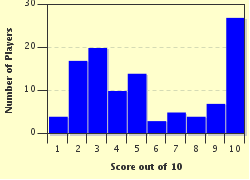Quiz Answer Key and Fun Facts
1. After ten plagues had been visited on Egypt, the Israelites were finally free to leave the country, but they were quickly pursued by the Egyptians. Having foreseen this, the Lord instructed the Israelites to march to the Red Sea (Exodus 13) as the first stage of their journey, eschewing the shorter road through which country?
2. The Red Sea and Pharaoh's armies safely behind them, the Israelites thirsted in the Desert of Shur, finding only bitter water at the place of Marah (Exodus 15). By the grace of the Lord, Moses turned this water drinkable by throwing something into it that the Lord had shown him - what was it?
3. After thirst, the next problem the tribes of Israel faced was hunger - it looked like they would starve in the desert before the Lord provided them with manna and quail (Exodus 16). This happened in a desert whose name, read as an English word, is quite fitting to those Israelites who still doubted the Lord. What is this desert's name?
4. Finally, the tribes of Israel arrived at Mount Sinai, where the Lord commanded Moses to ascend and receive the commands of the Law. However, when Moses returned, he found the Israelites to have constructed themselves a golden idol to pray to. His reaction was rather violent (Exodus 32), but which of these did Moses NOT do?
5. At the start of their second year of their long walk, the Israelites were still camped near Mount Sinai (Numbers 1), when a Census was taken. Which of the twelve tribes (not including the Levites) had the largest number of men able to serve in the army and which had the smallest?
6. The twelve tribes were arranged in four camps, surrounding the central camp of the Levites. Each camp contained three tribes and the Lord commanded a specific marching order for these four camps. Which camp was first in the marching order (Numbers 2)?
7. Having built, dedicated and consecrated the Tabernacle, the Israelites finally left Mount Sinai towards the Promised Land. On which day did this occur? (Numbers 10)
8. Not long after leaving Mount Sinai, the Israelites arrived at the borders of the Promised Land and sent scouts to survey it who found fertile lands and fresh fruit. However, the Lord decreed that they would not be allowed to enter the land for forty years (Numbers 14), as a punishment for what transgression?
9. With the forty years nearing their end, it was also time that Moses and Aaron were to be called by the Lord to be gathered to their people - in other words, die. Aaron was called first (Numbers 20), dying on Mount Hor which was situated on the borders of which country?
10. Finally, in sight of the Promised Land, Moses was also called to his people, passing leadership to Joshua who would lead them into Canaan, ending the Israelites' long walk. Which of these descriptions with regard to Moses' death is TRUE and documented in Deuteronomy 34?
Source: Author
WesleyCrusher
This quiz was reviewed by FunTrivia editor
LeoDaVinci before going online.
Any errors found in FunTrivia content are routinely corrected through our feedback system.

